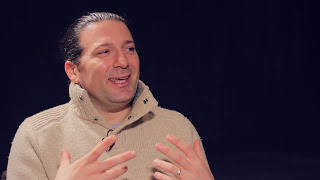In Chapter 11 of 16 in her 2012 interview, author and food writer Cathy Erway answers "At This Moment in Your Life, Where are You Seeking Advice and Coaching?" Erway details how she is learning from experienced food writer mentors and the steps she has taken to build relationships with them over time.
Cathy Erway is an author and food writer living in Brooklyn. Her first book, "The Art of Eating In" developed from her blog "Not Eating Out in New York". She earned a BA in creative writing from Emerson College.
Transcript:
Erik Michielsen: At this moment in your life, where are you seeking advice and coaching?
Cathy Erway: At this moment, I am seeking advice and coaching from veteran food writers. I love to talk to them, hang out with them, eat with them. As well as I found that older, you know, food writers really like to hear what's going on with the youth culture, so it's a win-win. I have a few friends that had been doing cookbooks for decades and, we don't really, like, so much talk about cookbooks all the time. We kind of just hang out and maybe we will talk about the Super Bowl and just other stuff, you know, our families, what's going on in politics, but, you know, if we ever need each other's advice--like I've been helping a certain older food writer friend get into Twitter and do more social media and stuff like that, and figure all that stuff out. And I'm sure I will go back to him if I ever need a contact at The New York Times or something.
Erik Michielsen: And do you find there’s just inspiration that comes from being in that group's presence independent of what specific thing you're talking about?
Cathy Erway: Well, for me, definitely. Because the older, the more experienced you are, the more foods you know about, I think. I mean it's really a learning experience, the more places they've probably been around the world, so, yeah, I love hearing about that kind of thing and I will ask them endlessly and they're like, "Oh, and then in Barcelona, we went and had these snails..." you know, so I just love hearing about it I was like, "I wanna go."
Erik Michielsen: Have you ever been intimidated asking, you know, to be part of that conversation, be part of those gatherings, and if so, how did you overcome that, you know, trepidation and push yourself in there?
Cathy Erway: No. No, I don't think so. I mean I will, like if I see a food critic at a party, say we're at the same event, and it's a public event, right? And some people are shy to walk up to people. I'm not, you know? Or email them out of the blue, because a lot of times they'll respond and they're really awesome. I try to do that to people that email me out of the blue. Maybe I don't get to all of them, I don't know, I think I do. If anyone's listening. I don't know, I mean, I think that it's, you know, if you wanna talk to them, they'll probably be happy to talk to you, too.




















